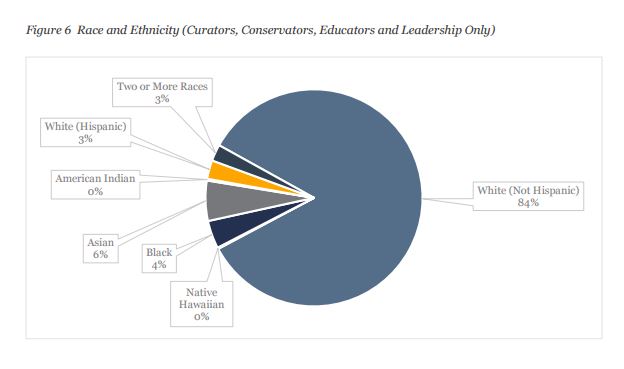Art World
Mellon Foundation Study Reveals Uncomfortable Lack of Diversity in American Museums
Unsurprisingly, white people hold the majority of leadership positions.

Unsurprisingly, white people hold the majority of leadership positions.

Brian Boucher

The Mellon Foundation, along with the Association of Art Museum Directors (AAMD) and the American Alliance of Museums (AAM), has released the disappointing results of a survey that assesses gender and ethnic diversity of museum staffs in the United States.
While the picture has brightened for women, who represent as much as 60 percent of museum staff members in professional fields like curatorial, conservation, and education roles, representation of non-white staffers remains mainly among security, facilities, finance, and human resources jobs.
“To thrive in the long term, it is crucial that museums bring the demographic profile of their staff into alignment with that of the communities they serve,” said Elizabeth Merritt, director of AAM’s Center for the Future of Museums in the 13-page report. “This will require challenging a broad range of assumptions about how museums train, recruit and manage the staff responsible for collections, interpretation, education and leadership of our institutions. And it will require taking a hard, uncomfortable look at the conscious and unconscious influences that have shaped our institutional culture and created the current imbalance.”
Undertaken with the assistance of New York research firm Ithaka S+R, the study surveyed 181 North American art museums, almost all in the US. That represents 77 percent of AAMD institutions.
One bright moment in an otherwise gloomy report shows that museum leadership positions (such as director, chief curator, or head of conservation or education) are approximately equally staffed by male and female employees.
Non-Hispanic white staff represent 84 percent of what the Mellon study identifies as “the job categories most closely associated with the intellectual and educational mission of museums, including those of curators, conservators, educators, and leadership.” Six percent of those positions are occupied by Asian people, four percent by blacks, three percent by Hispanic whites, and three percent by people who identify as “two or more races.”
“With the exception of the Asian demographic category, which makes up 5% of the United States population today, these proportions do not come close to representing the diversity of the American population,” the study points out.
Museum staffs range from 100 percent white to 100 percent minority, the report says. While some museums do have 100 percent minority staffs, those institutions are often culturally specific institutions; museums with 100 percent white staff may be located in areas with comparatively low minority populations.
“While the results of the 2015 art museum staff demographic survey may seem discouraging, they provide baseline data against which future surveys can be measured, and, one hopes, progress tracked,” Mariët Westermann, Andrew W. Mellon Foundation vice president, writes in the introduction.
The survey follows a $2 million initiative by the Mellon Foundation, undertaken in 2013, to create undergraduate curatorial fellowships for students of color at the Los Angeles County Museum of Art, the Art Institute of Chicago, the High Museum of Art in Atlanta, the Museum of Fine Arts Houston, and the Nelson-Atkins Museum of Art, Kansas City, Missouri.
It also coincides with a campaign by Tom Finkelpearl, head of New York City’s Department of Cultural Affairs, to increase diversity among the city’s cultural institutions. Finkelpearl also aims to make New York more livable for artists.
Related stories:
We Asked 20 Women “Is the Art World Biased?” Here’s What They Said.
A Wake-up Call for the Whitney Biennial 2014
Mellon and Getty Foundations Pitch in to Save Detroit Institute of Arts